| Week | Month | Sunday | Monday | Tuesday | Wednesday | Thursday | Friday | Saturday |
| 0 | August | 1 | 2 Arrive in Geneva | 3 Classes Begin @ HWS | 4 | |||
| 1 | 5 Movie | 6 | 7 | 8 | 9 | 10 | 11 Mitchell arrives in Brisbane | |
| 2 | 12 | 13 | 14 | 15 Classes Finish in Geneva | 16 Group leaves Geneva | 17 | 18 Group arrives in Brisbane | |
| 3 | 19 City Center Orientation | 20 UQ Orientation and BBQ | 21 Classes Begin @ UQ | 22 | 23 Brisbane Forest Park, Mt Coot-tha | 24 | 25 | |
| 4 | 26 | 27 | 28 | 29 | 30 | 31 | 1 | |
| 5 | September | 2 | 3 North Stradbroke Island | 4 North Stradbroke Island | 5 North Stradbroke Island | 6 North Stradbroke Island | 7 North Stradbroke Island | 8 North Stradbroke |
| 6 | 9 | 10 | 11 | 12 | 13 | 14 | 15 Lamington National Park | |
| 7 | 16 Lamington National Park | 17 Lamington National Park | 18 Lamington National Park | 19 Lamington National Park | 20 | 21 | 22 | |
| 8 | 23 | 24 | 25 | 26 | 27 | 28 | 29 | |
| 9 | October | 30 | 1 Lady Elliot Island | 2 Lady Elliot Island | 3 Lady Elliot Island | 4 Lady Elliot Island | 5 Lady Elliot Island | 6 |
| 10 | 7 | 8 | 9 | 10 | 11 | 12 | 13 | |
| 11 | 14 | 15 Carnarvon Saddler Springs | 16 Carnarvon Saddler Springs | 17 Carnarvon Saddler Springs | 18 Carnarvon Saddler Springs | 19 Carnarvon Saddler Springs | 20 Carnarvon Saddler Springs | |
| 12 | 21 | 22 | 23 | 24 | 25 | 26 | 27 North Stradbroke Island? | |
| 13 | 28 North Stradbroke Island? | 29 North Stradbroke Island? | 30 Finals, Projects, & Reports | 31 Finals, Projects, & Reports | 1 Finals, Projects, & Reports | 2 Finals, Projects, & Reports. Final Banquet | 3 | |
| 14 | November | 4 Students Depart | 5 | 6 | 7 | 8 | 9 | 10 |
When: Fall 2001 tentative schedule: Preparation: 3-16 August in Geneva, NY 18 August--9 November in Australia (spring in Australia).
Faculty: The Hobart and William Smith directors for the term are Tom Glover of the Department of Biology and Kevin Mitchell of the Department of Mathematics and Computer Science. Professors Glover and Mitchell directed a similar program in the Fall of 1996 and 1998. Faculty from the University of Queensland will lecture in three courses and help organize the field work.
Where: The program is base at the University of Queensland (Australia's largest university) in Brisbane. Queensland is a state on the east coast of Australia and Brisbane is its capital city. With a current population of about 1.4 million, Brisbane is Australia's third largest city, but has a "small town" feel. It holds many attractions for visitors, including its abundant sunshine and tropical climate.
A major feature of the program is field work at four locations: North Stradbroke Island which is a sand island in Moreton Bay about two hours from Brisbane, Lamington National Park which is a subtropical rainforest about three hours from Brisbane, Lady Elliot Island which is a coral cay at the southern tip of the Great Barrier Reef, and the Saddler Springs--Mt Moffat section of Carnarvon National Park which is a drier, cattle ranching area of Queensland.
Anticipated Courses: The program courses are: The Terrestrial Ecology of Australia, The
Marine Ecology of Australia, Issues of Environmental Management and Conservation,
and a multidisciplinary course on Australian Culture, Society, and Contemporary Issues.
See below for more information.
Cost: Costs, which include all program travel in Australia, will be equivalent to the cost (tuition,
room, and board) of a term on campus, exclusive of the air fare to Australia. To control student costs,
we will obtain a group rate [current estimate $1490] for the flight from Rochester, NY to Brisbane.
This ticket will allow you to individually schedule the details of your return to the United States. This
will permit additional travel within Australia and/or New Zealand at the end of the program.
Financial Aid: HWS Students: Any aid that you currently receive is automatically applied to the costs of this
program, except for the work-study portion. Students not currently receiving aid, but who can
demonstrate need in meeting additional costs involved in off-campus study, may also apply for
support. Union Students: Similar, but see Professor Thomas for details.
Prerequisite courses: Introductory Biology and ideally a statistics course. Strongly recommended:
Additional courses in biology, geoscience, environmental studies, anthropology/sociology, or political
science.
Australian Faculty: David Yates, Department of Botany and Ian Tibbetts, Division of Marine
Science, both of the University of Queensland. Roger Clay: University of South Australia, Department
of Environmental and Recreation Management. All were associated with our previous programs.
Accommodations: Homestays with families in Brisbane.
Proposed number of students: 32--35.
The Terrestrial Ecology of Australia (Biology 23x)
This program examines the heritage of the terrestrial flora and fauna of Australia, and assumes a basic
familiarity with the biology and ecology of terrestrial systems. The origins and uniqueness of
Australia's flora and fauna will be discussed in light of continental drift, past and present Australian
environments. The program combines lectures and field-based tuition with essays and research reports
to develop knowledge of Australia's unique terrestrial environments and to provide the skills with
which to investigate them. Field activities include a half day field excursion during the first week of the
program in a eucalypt forest, five days on Stradbroke Island (a large sand island bearing mainly wallum
vegetation, jointly with the Marine Biology Program), and five days in rainforest at Lamington National
Park. Toward the end of the program, a week in an arid inland site, gives students further opportunity
to examine and explore aspects of terrestrial ecology shaped by the harsh environment.
The Marine Ecology of Australia (Biology 23y)
This program assumes some familiarity with biological and ecological principles, sampling techniques,
sampling and experimental design and statistics. The program draws together background knowledge of
Australian marine systems and maritime resources with a variety of concepts and exercises in marine
biology. The program takes participants from the rich diversity of the estuarine and coastal systems
around Moreton Bay to Lady Elliot Island on the Great Barrier Reef. It combines classroom lectures and
field-based learning with essays and research reports to provide an understanding of tropical marine
biology and ecology. Together with some fascinating side trips to consolidate information on other
aspects of Australian ecology and Australian life the program represents an intensive and diverse
teaching package that is unique in Australia.
Australian Culture, Society, and Contemporary Issues (BD 233)
Course to be organized by Glover and Mitchell. No prior knowledge is expected but an attention to news
and current affairs that relate to Australia in local print and electronic media would be advantageous.
As in the past, the lecturers will be drawn from a variety of disciplines and represent a range of
viewpoints. We expect to utilize staff from a variety of departments and programs (especially the
Australian Studies Program and the Aboriginal and Torres Strait Islander Studies Program) at the
University of Queensland and other resource people (e.g., David Watson, head of the Liberal Party in
Queensland and member of the Queensland Parliament, Lloyd Hancock of Saddler Springs Educational
Centre, and Grahame Walsh who is an international authority on aboriginal rock art). Topics may include
introductions to: Aboriginal Society and Culture; European Impact on the Environment; Sustainable
Agriculture and Development; the Australian Political System; the Economy of Australia, health care
("socialized medicine"), educational systems, or welfare; nuclear weapons in the South Pacific.
Discussions, journals, papers, and student presentations would provide a chance for reflection on the similarities and differences between the cultures of Australia and the United States. The field trips provide material for discussing issues of development and the Stradbroke and Carnarvon trips provide opportunities to raise issues related to the Aboriginal peoples of Australia.
Issues of Environmental Management and Conservation (ENV 2xx)
Depending on the backgrounds of students, this new course to be offered in part by Roger Clay of the
University of South Australia. Topics might include biodiversity, land conversion, coastal development,
fire ecology, use of biological indicator species, and Australia's National Park system. Much of the
lecture work for the course might be done during the program's preparation period in August before
departure with additional lectures on the Moreton Bay Catchment in Australia provided by the School of
Marine Science. In Australia, Glover and Mitchell would supervise students in developing final projects
and papers and grade their presentations and written work at the end of the term.
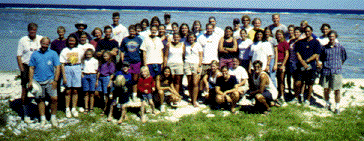
The students, staff, and staff families at Lady Elliot Island, December 1996.
The focus of this and previous the Queensland, Australia Science Terms Abroad was the marine and terrestrial ecology of Australia. The program integrated its field and lecture components. Courses on statistics and data analysis were included to provide the necessary background for students to do field-based projects that include a substantial quantitative component. Additionally, a course on the society and cultural history of Australia helped put contemporary social issues in Australia in perspective.
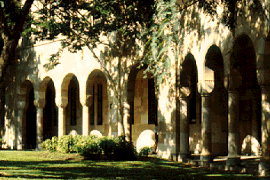 The program is based at the
University of Queensland
(Australia's largest university) in Brisbane. Queensland
is a state on the east coast of
Australia
and Brisbane is its capital city.
With a current population of about 1.25
million, Brisbane is Australia's third largest city, but has a "small town"
feel. It holds many attractions for visitors, including its abundant sunshine
and subtropical climate.
The program is based at the
University of Queensland
(Australia's largest university) in Brisbane. Queensland
is a state on the east coast of
Australia
and Brisbane is its capital city.
With a current population of about 1.25
million, Brisbane is Australia's third largest city, but has a "small town"
feel. It holds many attractions for visitors, including its abundant sunshine
and subtropical climate.
The Great Court at the University of Queensland.
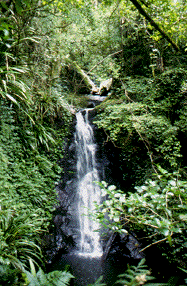 A major feature of the program were the field trips of five to seven days to each of
these four locations:
A major feature of the program were the field trips of five to seven days to each of
these four locations:
Waterfall at Lamington National Park.
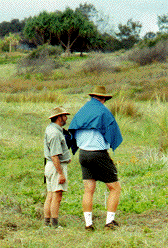 The Hobart and William Smith directors for the term were
The program directors were Professor Thomas Glover of
the Department of Biology and
Professor Kevin Mitchell of the Department
of Mathematics and Computer Science. Both have directed similar
programs before. Two faculty from the
University of Queensland,
David Yates in the
Department of Botany and
Ian Tibbetts of the
School of
Marine Science, will direct one course and the field work. Both were associated
with the 1994, 1996, and 1998 programs.
The Hobart and William Smith directors for the term were
The program directors were Professor Thomas Glover of
the Department of Biology and
Professor Kevin Mitchell of the Department
of Mathematics and Computer Science. Both have directed similar
programs before. Two faculty from the
University of Queensland,
David Yates in the
Department of Botany and
Ian Tibbetts of the
School of
Marine Science, will direct one course and the field work. Both were associated
with the 1994, 1996, and 1998 programs.
David Yates (left) and Tom Glover at 18-mile Swamp, North Stradbroke Island.
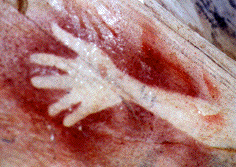
Red ochre stencil at Carnarvon Gorge.